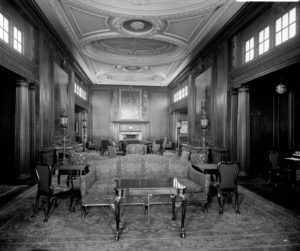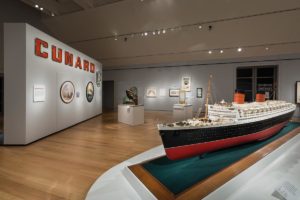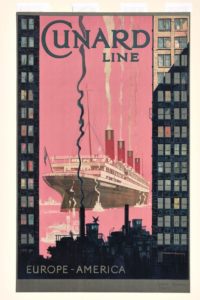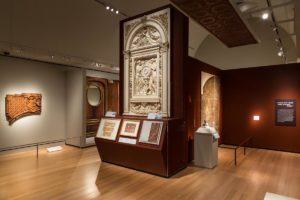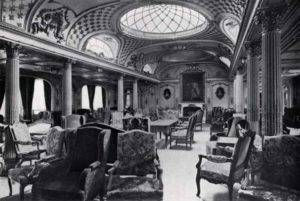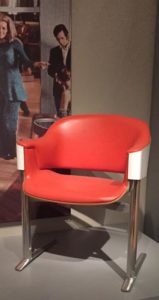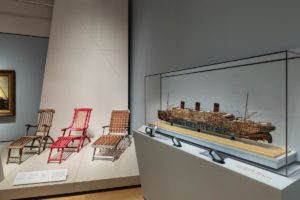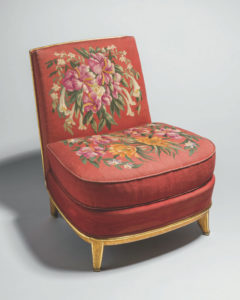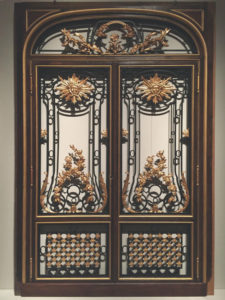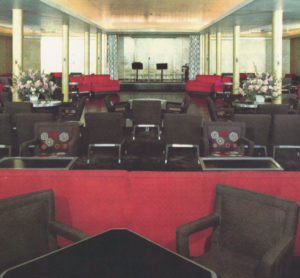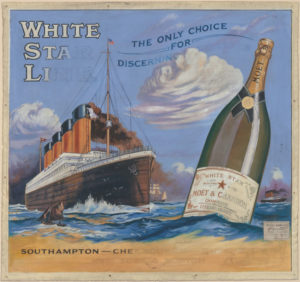Ocean Liners: Glamour, Speed, and Style
Traveling between the Peabody Essex Museum in Salem, MA, the Victoria and Albert Museum in London, and the new V&A Dundee in Scotland, Ocean Liners: Glamour, Speed, and Style is the first exhibition to fully explore the aesthetics and cultural impact of ocean liners from an international perspective. Incorporating spectacular loans from institutions and private collections across Europe and the United States, the show offers a chance to fully appreciate rare examples of iconic designs created for these opulent vessels through creative display techniques and high-tech immersive elements.
The exhibit is organized thematically: the history of promoting liners; shipbuilding; the palatial interiors of the Victorian and Edwardian liners; the emergence of the Art Deco style in the 1920s and 30s; the embrace of modernism after World War Two; fashion, consumption, and spectacle on board; and, finally, the influence of ocean liners on modern thought and public perception. Objects on display range from posters to engineer’s models, and historic fashion to furniture. The decorative arts are prominently showcased throughout the exhibit. In many instances objects that have not been seen together since on board their original vessels are reunited, conjuring a glimpse into the unique style that made these ships so legendary.
While visually delightful, the installations also speak to the developing role of design in the political and economic discourse of the 20th century. Early ocean liners were small, poorly-lit, and terrifyingly uncomfortable in rough weather. They featured passenger quarters designed by well-regarded architects and interior decorators whose work was popular in the great county houses and luxury hotels of Europe. Although liners had greatly improved in terms of size, speed, and comfort by the turn of the 20th century, they still relied on historical precedents for their interior décor. Two of the most successful liners of the early 20th century, the SS France and the RMS Aquitania, replicated interiors from land-based precedents. The France quickly gained the nickname “The Versailles of the Atlantic” for good reason. Architectural elements were copied from 17th- and 18th-century Baroque examples from around Paris, including the old Bibliothèque Nationale and the Hôtel de Toulouse. The first class lounge featured replica portraits of Louis XIV and a selection of his courtiers (including several of his mistresses). Likewise, the interiors of the Cunard Line’s Aquitania featured the peak of prewar fashion. Spaces such as the first class lounge or smoking room were restyled as the “Palladian Lounge” and the “Carolian Smoking Room,” employing direct quotations from famous architectural examples. The smoking room, for example, copied the paneling from an interior at the Greenwich Naval Hospital, added limewood carvings in the style of Grinling Gibbons, and paintings inspired by masterpieces in the National Gallery. Furniture from the Frederick Parker Company, which specialized in accurate reproductions of period pieces, complemented the spaces. Ocean Liners includes paneling and furniture from the France, original concept drawings for the Aquitania, as well as recovered woodwork from the Titanic paired with examples from her nearly identical sister ship Olympic.
World War One changed the global political and economic landscape, and the effects were immediately felt by the shipping industry. The changing market of passenger travel hindered the rebuilding of commercial fleets. Between 1921 and 1925, the United States government enacted strict immigration limits, greatly reducing overall passenger traffic. Ocean liners quickly began to reflect the new realities of the 1920s, not only by cashing in on the phenomenon of budget-conscious tourism by the American middle-class, but also by turning to design to proclaim modern national identity.
The French Line’s SS Ile de France was the first major liner designed and built after the war. Famously incorporating Art Deco styling for all her interiors, this project helped modernism gain a viable foothold in the United States. French Line president Jean dal Piaz justified this direction with the dictum “to live is not to copy, but is to create.” The company hired many of the French designers and craftsmen whose work took the art world by storm at the 1925 Paris World’s Fair. Their work on the Ile de France ended the dominance of historical revivalism on ocean liners, while demonstrating new ways of proclaiming French national identity. For example, in the first class salon, the design partners Louis Sue and Andre Mare turned to art and textile design to pay homage to cities and town throughout the ship’s namesake Ile de France region, and designed the space and furniture around those elements. Large-scale sculptures thematically illustrated the area’s cultural heritage, while each sofa featured specially woven upholstery displaying the name and defining landmark of every major city in the province. The furniture itself was a theatrical backdrop, combining modern design with overt national pride. During the 1920s and 30s, the Ile de France became France’s “ship of state,” ferrying French diplomats across the Atlantic on official business and often serving as a floating embassy in New York.
Within two years, Art Deco became the go-to style for new ocean liners, and vessels such as the German Bremen and Europa, the Italian Conte di Savoia, and the British Queen Mary all featured various iterations of this style. To incorporate national identity, the designers and their materials took on a more prominent public role. For example, the Queen Mary’s promotional materials now proudly listed each individual designer, while
a popular on-board souvenir was a photo book of all the different woods used in the ship’s paneling and furniture, which was symbolically sourced from throughout the British Empire. The exhibition features numerous examples of several renowned ocean liners, pairing furniture from the Ile de France, Normandie, and Queen Mary with original decorative paneling.
World War Two brought another round of changes to the shipping industry, primarily in response to the development of aviation technology and introduction of commercial global airline travel. To remain competitive, companies fully capitalized on Postwar Modernism for the appeal of fashionable interiors, as well as the promise imbued in the latest technology and materials, which helped the vessels remain efficient and profitable for as long as possible in the face of increasing competition. Several ships from this era are well represented in the exhibit, particularly the SS United States, whose interiors had the additional benefit of being completely fireproof.
The Cunard Line’s Queen Elizabeth 2 was the last true ocean liner built during the 20th century, and brought ocean-going modernism to almost space-age futurism. The QE2 was a national project, funded by a generous government loan, and became a national icon of the late 1960s. Advocates of modern design mounted a successful campaign to use the passenger spaces as a showcase, and her interiors were planned by a large team of the leading architects and designers under the general supervision of British industrial designer James Gardner. Gardner sought to once again eschew most historical precedents and references on board, and the brochure commemorating the ship’s 1969 debut boldly declared on the cover that “SHIPS HAVE BEEN BORING LONG ENOUGH.” Furnishings drew on inspirations from iconic 1960s furniture, including Eero Saarinen’s “Tulip” pedestal table and William Plunkett’s modular “Kingston” range of furniture, and employed bright colors, synthetic materials, and shiny aluminum surfaces to create a “fun and futuristic” atmosphere. While the QE2’s passenger spaces certainly were not boring, they received mixed reviews from both critics and passengers, and were largely replaced ten years into the vessel’s career.
Ocean liners were important economic, political, and technological entities, and their influence was felt far beyond the people who sailed on them. Adherents to modernity, from the architect Le Corbusier and the artist Alfred Steiglitz to the philosopher Michel Foucault and author Ernest Hemingway, revered the massive power and presence of ocean liners for what they represented: repositories of human knowledge, skill, ambition, and imagination. Fittingly the exhibition closes with a gallery dedicated to the role of liners in cultural imagination and popular opinion, including works of art they inspired, consumer products inspired by the streamlined style they championed, and architecture that references their unique forms. The history of ocean liners survives through their momentous role in shaping how the modern world travels, moves, and connects to people and design from around the globe.
Traveling between the Peabody Essex Museum in Salem, MA, the Victoria and Albert Museum in London, and the new V&A Dundee in Scotland, Ocean Liners: Glamour, Speed, and Style is the first exhibition to fully explore the aesthetics and cultural impact of ocean liners from an international perspective. Incorporating spectacular loans from institutions and private collections across Europe and the United States, the show offers a chance to fully appreciate rare examples of iconic designs created for these opulent vessels through creative display techniques and high-tech immersive elements.
The exhibit is organized thematically: the history of promoting liners; shipbuilding; the palatial interiors of the Victorian and Edwardian liners; the emergence of the Art Deco style in the 1920s and 30s; the embrace of modernism after World War Two; fashion, consumption, and spectacle on board; and, finally, the influence of ocean liners on modern thought and public perception. Objects on display range from posters to engineer’s models, and historic fashion to furniture. The decorative arts are prominently showcased throughout the exhibit. In many instances objects that have not been seen together since on board their original vessels are reunited, conjuring a glimpse into the unique style that made these ships so legendary.
While visually delightful, the installations also speak to the developing role of design in the political and economic discourse of the 20th century. Early ocean liners were small, poorly-lit, and terrifyingly uncomfortable in rough weather. They featured passenger quarters designed by well-regarded architects and interior decorators whose work was popular in the great county houses and luxury hotels of Europe. Although liners had greatly improved in terms of size, speed, and comfort by the turn of the 20th century, they still relied on historical precedents for their interior décor. Two of the most successful liners of the early 20th century, the SS France and the RMS Aquitania, replicated interiors from land-based precedents. The France quickly gained the nickname “The Versailles of the Atlantic” for good reason. Architectural elements were copied from 17th- and 18th-century Baroque examples from around Paris, including the old Bibliothèque Nationale and the Hôtel de Toulouse. The first class lounge featured replica portraits of Louis XIV and a selection of his courtiers (including several of his mistresses). Likewise, the interiors of the Cunard Line’s Aquitania featured the peak of prewar fashion. Spaces such as the first class lounge or smoking room were restyled as the “Palladian Lounge” and the “Carolian Smoking Room,” employing direct quotations from famous architectural examples. The smoking room, for example, copied the paneling from an interior at the Greenwich Naval Hospital, added limewood carvings in the style of Grinling Gibbons, and paintings inspired by masterpieces in the National Gallery. Furniture from the Frederick Parker Company, which specialized in accurate reproductions of period pieces, complemented the spaces. Ocean Liners includes paneling and furniture from the France, original concept drawings for the Aquitania, as well as recovered woodwork from the Titanic paired with examples from her nearly identical sister ship Olympic.
World War One changed the global political and economic landscape, and the effects were immediately felt by the shipping industry. The changing market of passenger travel hindered the rebuilding of commercial fleets. Between 1921 and 1925, the United States government enacted strict immigration limits, greatly reducing overall passenger traffic. Ocean liners quickly began to reflect the new realities of the 1920s, not only by cashing in on the phenomenon of budget-conscious tourism by the American middle-class, but also by turning to design to proclaim modern national identity.
The French Line’s SS Ile de France was the first major liner designed and built after the war. Famously incorporating Art Deco styling for all her interiors, this project helped modernism gain a viable foothold in the United States. French Line president Jean dal Piaz justified this direction with the dictum “to live is not to copy, but is to create.” The company hired many of the French designers and craftsmen whose work took the art world by storm at the 1925 Paris World’s Fair. Their work on the Ile de France ended the dominance of historical revivalism on ocean liners, while demonstrating new ways of proclaiming French national identity. For example, in the first class salon, the design partners Louis Sue and Andre Mare turned to art and textile design to pay homage to cities and town throughout the ship’s namesake Ile de France region, and designed the space and furniture around those elements. Large-scale sculptures thematically illustrated the area’s cultural heritage, while each sofa featured specially woven upholstery displaying the name and defining landmark of every major city in the province. The furniture itself was a theatrical backdrop, combining modern design with overt national pride. During the 1920s and 30s, the Ile de France became France’s “ship of state,” ferrying French diplomats across the Atlantic on official business and often serving as a floating embassy in New York.
Within two years, Art Deco became the go-to style for new ocean liners, and vessels such as the German Bremen and Europa, the Italian Conte di Savoia, and the British Queen Mary all featured various iterations of this style. To incorporate national identity, the designers and their materials took on a more prominent public role. For example, the Queen Mary’s promotional materials now proudly listed each individual designer, while
a popular on-board souvenir was a photo book of all the different woods used in the ship’s paneling and furniture, which was symbolically sourced from throughout the British Empire. The exhibition features numerous examples of several renowned ocean liners, pairing furniture from the Ile de France, Normandie, and Queen Mary with original decorative paneling.
World War Two brought another round of changes to the shipping industry, primarily in response to the development of aviation technology and introduction of commercial global airline travel. To remain competitive, companies fully capitalized on Postwar Modernism for the appeal of fashionable interiors, as well as the promise imbued in the latest technology and materials, which helped the vessels remain efficient and profitable for as long as possible in the face of increasing competition. Several ships from this era are well represented in the exhibit, particularly the SS United States, whose interiors had the additional benefit of being completely fireproof.
The Cunard Line’s Queen Elizabeth 2 was the last true ocean liner built during the 20th century, and brought ocean-going modernism to almost space-age futurism. The QE2 was a national project, funded by a generous government loan, and became a national icon of the late 1960s. Advocates of modern design mounted a successful campaign to use the passenger spaces as a showcase, and her interiors were planned by a large team of the leading architects and designers under the general supervision of British industrial designer James Gardner. Gardner sought to once again eschew most historical precedents and references on board, and the brochure commemorating the ship’s 1969 debut boldly declared on the cover that “SHIPS HAVE BEEN BORING LONG ENOUGH.” Furnishings drew on inspirations from iconic 1960s furniture, including Eero Saarinen’s “Tulip” pedestal table and William Plunkett’s modular “Kingston” range of furniture, and employed bright colors, synthetic materials, and shiny aluminum surfaces to create a “fun and futuristic” atmosphere. While the QE2’s passenger spaces certainly were not boring, they received mixed reviews from both critics and passengers, and were largely replaced ten years into the vessel’s career.
Ocean liners were important economic, political, and technological entities, and their influence was felt far beyond the people who sailed on them. Adherents to modernity, from the architect Le Corbusier and the artist Alfred Steiglitz to the philosopher Michel Foucault and author Ernest Hemingway, revered the massive power and presence of ocean liners for what they represented: repositories of human knowledge, skill, ambition, and imagination. Fittingly the exhibition closes with a gallery dedicated to the role of liners in cultural imagination and popular opinion, including works of art they inspired, consumer products inspired by the streamlined style they championed, and architecture that references their unique forms. The history of ocean liners survives through their momentous role in shaping how the modern world travels, moves, and connects to people and design from around the globe.

